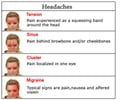Women age 45 years or older who experience migraines with aura are at a higher risk for heart attack, ischemic stroke, angina and death due to ischemic cardiovascular disease.
Women age 45 years or older who experience migraines with aura (associated neurologic symptoms such as temporary visual disturbances) are at a higher risk for heart attack, ischemic stroke, angina and death due to ischemic cardiovascular disease compared to women who do not report a migraine history. In contrast, migraine without aura, the most common form of migraine, was not associated with increased risk of any cardiovascular event.
In the United States, the 1-year prevalence of migraine is approximately 18 percent in women and 6 percent in men; an estimated 28 million Americans have severe and disabling migraines, according to background information in the article. Migraine with aura has been previously linked with increased risk of ischemic stroke. Since some studies have suggested that migraine, particularly migraine with aura, is associated with an unfavorable cardiovascular risk profile, an association with other cardiovascular disease (CVD) is plausible but has not been firmly established.Tobias Kurth, M.D., Sc.D., of Brigham and Women’s Hospital and the Harvard School of Public Health, Boston, and colleagues evaluated the association of migraine with or without aura and subsequent risk of overall and specific CVD. The study included 27,840 women, age 45 years or older, who were participating in the Women’s Health Study, were free of CVD and angina at study entry (1992-1995), and who had information on self-reported migraine and aura status and lipid measurements.
At baseline, 5,125 women (18.4 percent) reported a history of migraine; of the 3,610 with active migraine (migraine in the prior year), 1,434 (39.7 percent) indicated aura symptoms. During an average of 10 years of follow-up, 580 major CVD events occurred.
The researchers found that any history of migraine was associated with increased risk of major CVD. This increased risk differed according to aura status. Compared with no migraine history, women who reported active migraine with aura had a significantly increased risk of subsequent major cardiovascular events, ischemic stroke, heart attack, coronary revascularization, angina, and death due to ischemic CVD. These increased risks, which remained after adjusting for a large number of cardiovascular risk factors, ranged from a 1.7-fold increase for coronary revascularization to a 2.3-fold increase for ischemic cardiovascular disease death. In contrast, women who reported active migraine without aura did not have significantly increased risk for any ischemic vascular event.
“Since migraine without aura is far more common than migraine with aura, our data demonstrate no increased risk of CVD for the majority of migraine patients. Future research should focus on a better understanding of the relationship between migraine, aura status, and cardiovascular events,” the authors conclude.
(Source: Newswise)











